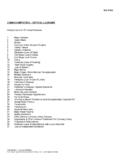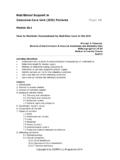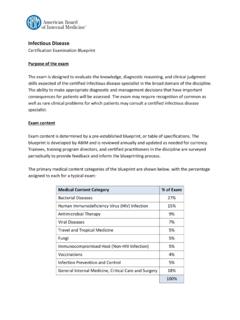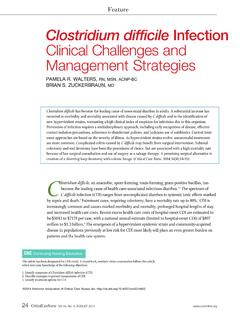Transcription of PRODUCT MONOGRAPH - Valeo Pharma
1 PRODUCT MONOGRAPH PrSYNACTHEN DEPOT Tetracosactide Zinc Injection, Mfr. Std. (also known as cosyntropin injection) 1 mg/mL tetracosactide Adrenocorticotropic Hormone Questcor Operations Limited DATE OF REVISION: 70 Sir John Rogerson s Quay June 19, 2015 Dublin 2 Ireland Control No: 183644 SYNACTHEN is a registered trademark 2015 Questcor Operations Limited All Rights Reserved - 2 - PRODUCT MONOGRAPH PrSYNACTHEN DEPOT Tetracosactide Zinc Injection, Mfr. Std. (also known as cosyntropin injection) 1 mg/mL tetracosactide PHARMACOLOGICAL CLASSIFICATION Synthetic long-acting 1-24 corticotropin peptide ACTIONS AND CLINICAL PHARMACOLOGY Natural adrenocorticotropin is a straight-chain polypeptide containing 39 amino acids which, by convention, are numbered from the N-terminal end of the molecule.
2 The sequence of amino-acid occupying positions 25 to 33 varies among species and it is this part of the molecule which is most antigenic when ACTH of foreign origin is administered to man. In contrast, the N-terminal 24 amino-acid sequence is common to all species and is relatively non-antigenic, and it is only these amino-acids which are involved in its biological activities. The most important physiological effects of ACTH involve the adrenal cortex and include the maintenance of adrenal weight and the control of adrenal corticosteroid synthesis and release.
3 In its absence, adrenal blood flow is diminished, adrenal atrophy invariably ensues and cortisol secretion is markedly reduced. In addition to controlling corticosteroid secretion, ACTH also increases the synthesis and release of the other adrenal steroids, namely aldosterone and the adrenal androgens. It also has some degree of melanotropic activity and lipolytic effect. SYNACTHEN DEPOT (tetracosactide zinc injection), a long-acting synthetic 1-24-corticotropin, exhibits the same activity as natural ACTH with regard to all its biological activities.
4 The complex results in a PRODUCT whose absorption in man is effected over a longer period of time as compared to corticotropin. Therefore, therapy may be maintained with less frequent administration. The long-term administration of SYNACTHEN DEPOT produces the same effects as those produced by cortisone, cortisol and their synthetic analogues. In addition, there is also hypertrophy and hyperplasia of the adrenal cortex, in contrast to the effect of the exogenous corticoids.
5 INDICATIONS AND CLINICAL USE 1. Diagnostic Use for the Investigation of Adrenocortical Insufficiency SYNACTHEN DEPOT (tetracosactide zinc injection) is intended for use as a diagnostic agent in the screening of patients presumed to have adrenocortical insufficiency. To determine the - 3 - functional reserve of the adrenal cortex, a 5-hour test can be performed using SYNACTHEN DEPOT. Plasma-cortisol should be estimated before and 4-6 hours after an injection of 1 mg SYNACTHEN DEPOT.
6 2. Therapeutic Use Collagen Diseases: Acute rheumatic fever; rheumatoid arthritis; lupus erythematosus; periarteritis nodosa, psoriatic arthritis; scleroderma; rheumatoid spondylitis; Still's disease. Dermatologic Diseases: Exfoliative dermatitis; dermatomyositis; pemphigus. Endocrine Diseases: Panhypopituitarism. Eye Diseases: Choroiditis; conjunctivitis; iritis; keratitis; optic neuritis; sympathetic ophthalmia; uveitis. Hemolytic Diseases: Acquired hemolytic jaundice.
7 Other Diseases: Nephrotic syndrome; ulcerative colitis; Bell's palsy; acute exacerbations of multiple sclerosis, and as adjuvant treatment in cases of acute gout. CONTRAINDICATIONS Known or suspected hypersensitivity to tetracosactide (also known as cosyntropin) and/or ACTH of animal origin or to any of the excipients of SYNACTHEN DEPOT (tetracosactide zinc injection). SYNACTHEN DEPOT must not be used to treat asthma or other allergic conditions due to the increased risk of anaphylactic reactions (see WARNINGS and PRECAUTIONS).
8 Premature babies and neonates (less than 1 month), due to the presence of benzyl alcohol (see WARNINGS and DOSAGE AND ADMINISTRATION). Acute psychosis. Untreated bacterial, fungal and viral infections. Active or latent peptic ulcer. Refractory congestive heart failure. Cushing's syndrome. Treatment of primary adrenocortical insufficiency. Adrenogenital syndrome. WARNINGS SYNACTHEN DEPOT (tetracosactide zinc injection), MUST NOT BE GIVEN INTRAVENOUSLY. BENZYL ALCOHOL: Due to the presence of benzyl alcohol, SYNACTHEN DEPOT is not recommended in infants and children between 1 month of age and 3 years old, as it may cause toxic reactions and allergic reactions.
9 - 4 - In rare cases, particularly in patients subject to asthma and/or other forms of allergy - severe anaphylactic reactions may occur. Such reactions set in usually within 30 minutes after administration of SYNACTHEN DEPOT. If SYNACTHEN DEPOT is used in any of the following conditions, the risks should be weighed against the possible benefits: non-specific ulcerative colitis; diverticulitis; recent intestinal anastomosis; renal insufficiency; hypertension; thromboembolic tendencies; acute or chronic infections, especially varicella or vaccinia; exanthematous and fungal diseases; osteoporosis and myasthenia gravis.
10 The administration of ACTH for three consecutive days may cause sodium and water retention with the risk of edema while the marked and prolonged increase in circulating corticosteroid levels that may occur in patients with bilateral adrenal hyperplasia, can cause a severe exacerbation of the symptoms of Cushing's syndrome. On extremely rare occasions, adrenal crisis has supervened during prolonged ACTH stimulation in patients with marked adrenal insufficiency.







